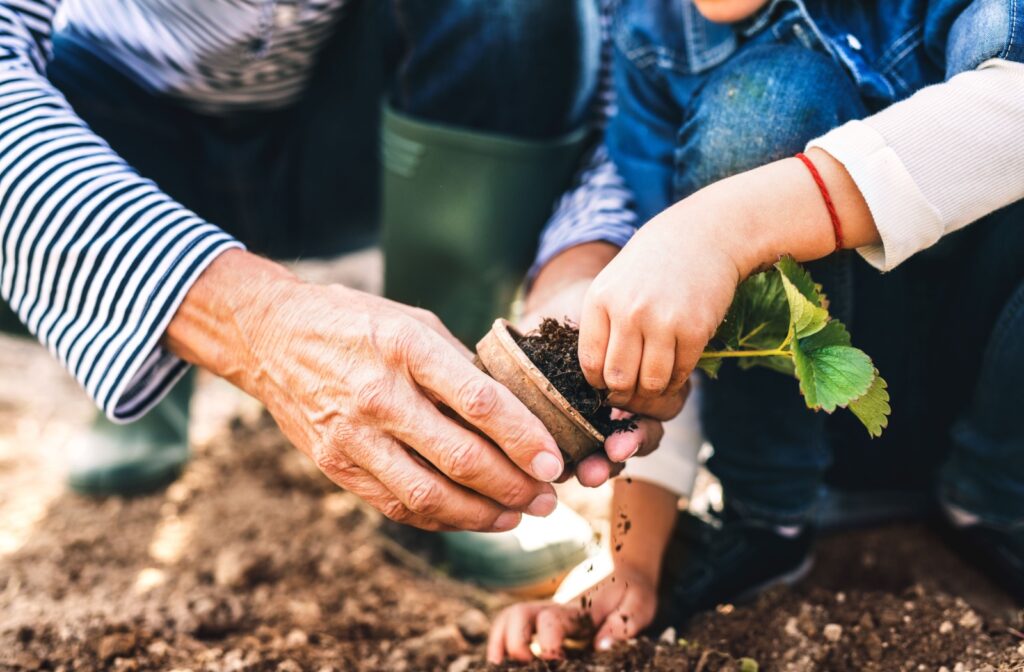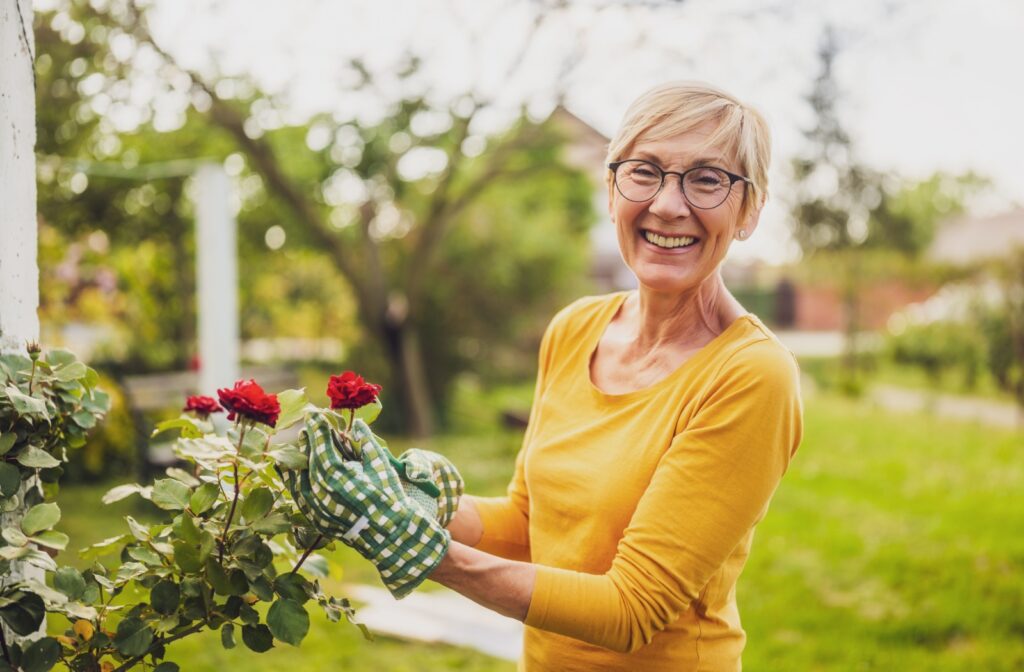Gardening is more than just a hobby. It’s a wonderful way for seniors to stay physically and mentally active. Not only does it provide an opportunity to enjoy the outdoors, but it also offers numerous health benefits.
Gardening can help improve and maintain physical, mental, and cognitive health.
Minnesota weather provides a window of a prosperous gardening season. Be particular about the types of plants you’d like to grow and whether they can sustain in this climate.
Seniors & Physical Activity
Older adults should aim to have at least 150 minutes of moderately intense physical activity per week and engage in some form of muscle-strengthening activity at least two times a week.
Gardening fits perfectly into this category. Activities such as raking, weeding, planting, and watering can elevate your heart rate while being gentle on the body.
Health Benefits of Gardening
Beyond enjoying the outdoors and spending time with yourself or others, gardening has several physical, mental, and cognitive benefits.
Physical Health Benefits
- Improves cardiovascular health: Tasks like digging and raking can get your heart pumping, which helps improve circulation. Gardening can be a great form of aerobic exercise to improve heart health.
- Enhances flexibility and strength: Reaching for tools, bending to plant, and pulling weeds are excellent ways to build muscle strength and flexibility.
- Balance: Activities requiring squatting, reaching, and moving around uneven surfaces enhance balance and prevent falls.
- Muscle toning: Tasks such as lifting pots, pushing wheelbarrows, and shoveling soil work for various muscle groups, improving strength and endurance. Gardening involves weight-bearing exercises that strengthen bones and reduce the risk of osteoporosis.
- Vitamin D exposure: Gardening in sunlight helps the body produce vitamin D, which is crucial for bone health and calcium absorption. Taking vitamin D supplements in the winter can help maintain and improve bone health during winter months when sun exposure is less.
Mental Health Benefits
Gardening also has profound mental health benefits, particularly for older adults. Being outdoors and engaging in a purposeful activity can greatly improve one’s mood and overall mental well-being.
- Reduces stress and anxiety: The repetitive tasks involved in gardening can be meditative and calming, reducing levels of cortisol, the stress hormone.
- Boosts mood: Exposure to natural sunlight increases the production of serotonin, a mood-enhancing chemical in the brain.
- Provides a sense of accomplishment: Watching your plants grow and thrive provides a sense of achievement and purpose.
Cognitive Health Benefits
Engaging in activities that stimulate the mind is crucial as we age. Gardening can help keep cognitive functions sharp.
- Enhances memory: The various tasks and decisions involved in gardening can enhance memory-related functions.
- Fine motor skills: Handling small seeds and delicate plants improves fine motor skills and hand-eye coordination.
- Improves attention span: Focusing on different gardening activities can improve attention span and concentration.
- Encourages learning: Constantly learning about new plants, gardening techniques, and problem-solving methods can keep the brain active and engaged.

Gardening in Minnesota
Gardening in Minnesota comes with its own set of challenges and opportunities. Here are some tips to help older adults have a successful gardening season.
Understanding Frost Dates
Unfortunately, the climate in Minnesota limits the duration of the gardening season. To enjoy the fruits of one’s labor, one cannot begin their garden too early. The weather may pose a risk to the growing conditions of plants.
- Last frost date: Typically, the last frost date in Minnesota ranges from mid-May to late May, depending on the specific region. We recommend beginning to garden closer to the end of May or early June when weather patterns become more consistent.
- First frost date: The first frost usually occurs between late September and early October. Seasonal gardens will likely begin wilting around this time.
It’s important to consider the kinds of plants and vegetables you’ll be growing this season.
Some plants (cool season crops) can be planted before late frost in late April or early May. They can be planted as soon as the soil is workable. These include:
- Vegetables: Lettuce, spinach, peas, radishes, kale, and broccoli.
- Flowers: Pansies, snapdragons, and calendula.
After the last first in late May or early June, warm-season crops can be planted once the weather conditions of late spring have passed. These include:
- Vegetables: Tomatoes, peppers, cucumbers, squash, beans, and corn.
- Flowers: Marigolds, zinnias, petunias, and sunflowers.
If one begins their warm-season crops in early June, it’ll allow your garden 4 whole months to grow and prosper during the summer months.
Cool-season crops to prepare for a fall harvest can be planted during the late summer months of August-Sepetember. While the growing season is short, some cool-season crops to consider planting include lettuce, spinach, and radishes.
Selecting the Right Plants
The climate in Minnesota can be harsh. The winters are cold, and the summers can become very humid. For a successful garden, it is important to choose the right plants that will prosper in this climate.
- Perennials: These plants come back year after year, making them low-maintenance. Consider options like hostas, daylilies, and coneflowers.
- Annuals: These plants complete their life cycle in one growing season but offer vibrant, continuous blooms. Marigolds, petunias, and zinnias are excellent choices.
- Vegetables: Some vegetables thrive in Minnesota’s climate. Consider growing cool-season crops like lettuce, spinach, and radishes in the spring and fall.
Practical Gardening Tips
- Raised beds: Using raised beds can make gardening less strenuous, reducing the need to bend over. A raised bed can reduce the risk of animal invasion in your crops! It’ll become more difficult for rabbits, rodents, and raccoons to nibble in your beautiful garden.
- Proper tools: Invest in ergonomic tools that are easier to grip and require less strength to use. These tools are designed for individuals who comfortably engage in repetitive activity (common in gardening) and reduce the risk of injury.
- Pacing: Take breaks frequently to avoid overexertion, especially on hot days. Do what you can. Overworking yourself can lead to several concerns, such as fatigue, muscle cramping, and dehydration.
- Hydration: Always have water available to stay hydrated while working outdoors.
- Sun protection: Wear a hat and sunscreen to protect against UV rays. We can still gain the benefits of vitamin D under sun protection!
Schedule a Tour!
Gardening is an excellent way for seniors to stay active and healthy, offering numerous physical, mental, and cognitive benefits.
With the right plants and practical tips, outdoor gardening in Minnesota can be a fulfilling and successful endeavor.
Meet our community of gardeners at Round Lake Senior Living! Connect with our team to schedule a tour and visit our gardens!



